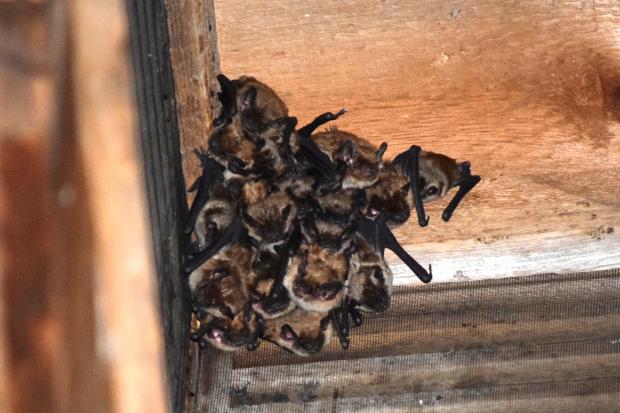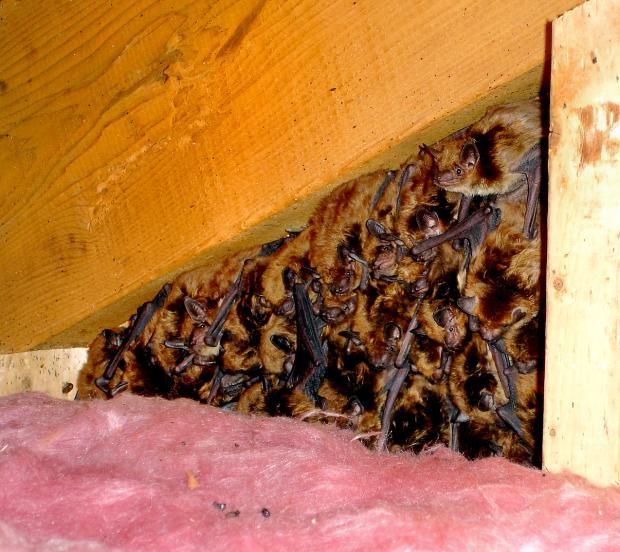The Massachusetts Homeowner's Guide to Bats has information and advice on how to evict and relocate bats, plus tips on handling a bat, designs for one-way doors, and bat house plans. This guide also features a key to identifying the nine bat species in Massachusetts.
Report Bat Colonies
Due to recent catastrophic mortalities of bats from White Nose Syndrome (WNS), MassWildlife biologists would like reports of summer bat colony locations. If you see a colony of bats (10 or more bats), please let us know. We study bat colonies in Massachusetts to see how many have survived after the onset of White-nose Syndrome. Our monitoring also leads to advances in conservation and management for endangered bat species, ensuring protection and security of the colonies. To report bat colonies, please complete this survey. Please include the address, location, type of structure (tree, building, attic, barn, shed, or other outbuilding), roughly how many bats are in the colony, and approximately how long the bats have been there. Your help is greatly appreciated!
(Please note that this survey is for reporting purposes and surveys will not receive a response.)
Bats in Your Home
In the summer, with hot, humid weather, some homeowners may discover bats residing in their home. Attics are the most common area of a house in which bats are most likely to roost and gather in a colony to raise their young. The heat of an attic keeps the pups warm and allows them to grow and develop more rapidly. After a few very hot summer days, an attic may become too hot for the bats, forcing them out and sometimes into the living quarters as they search for cooler places to roost. In late summer, inexperienced young bats may fall down a chimney, fly down an attic stairway, fly through an open window, or land on the ground.
Additional Resources
-
Open PDF file, 2.64 MB, Living with Bats - printable fact sheet (English, PDF 2.64 MB)
-
Open PDF file, 564.21 KB, Build a four-chamber bat house (English, PDF 564.21 KB)
-
Open PDF file, 2.34 MB, Massachusetts Wildlife Magazine No. 3, 2019: Bat Myths Debunked (English, PDF 2.34 MB)
Evicting Bats from Your Home
During warmer months, most bats found in buildings (like homes) are either little brown bats or big brown bats.
The presence of any wild animal, including bats, in a home is an obvious indication that the house is not weather-tight. It’s important to note that bats can squeeze through a hole as small as 1/2 inch. In some cases, with small numbers of bats, people don't mind their presence and concentrate on blocking holes and cracks leading into the human living quarters. Where there is a large colony of bats in house walls, homeowners may consider removing and relocating the bats. Massachusetts requires non-lethal approaches through the use of one-way doors. The only long-term solution to keep the bats out is to bat-proof your entire house by blocking all possible entrances that are 1/2 inch or larger using a good sealing material, leaving the one primary entrance open with a one-way door. One-way doors allow bats to leave the structure, but not re-enter. Since not all bats will exit every night, one-way doors should be left in place for a minimum of five nights, including at least three consecutive nights of good weather (above 50 degrees F, winds below 10 mph, and no heavy rains) before the one-way doors are removed and the holes are sealed. If weather conditions are not conducive to bat flight, the one-way doors should be left in place longer.
It may also be helpful to put up a bat house nearby to provide an alternate site for the bats. For information on bat houses, including installation recommendations, please see MassWildlife's Guide to Bat Houses.
Since bats are protected in Massachusetts, attempts to evict a colony of bats can only be made during the early spring (during the month of May), or late summer (from August 1st to mid-October). During the month of May, temperatures are warm enough for bats to leave roost sites via one-way doors to hunt at night, but this is before the maternity season when mothers have their pups. August through mid-October is when the pups have learned to fly and can leave the roost, but this is before the bats enter hibernation. Waiting to evict the colony allows time for any young bats to mature and leave the house on their own. Attempts to evict or exclude bats during the maternity season (June and July) may result in the death of flightless young from being trapped inside and may also lead to an increase in the number of adult bats and orphaned pups that enter the living space. Additionally, roost closure during the maternity season has been documented to result in lower reproductive success.
Bat exclusions and evictions should not be performed during the winter because big brown bats often hibernate in homes and attics. When the bats awake from hibernation in the spring, they will be entrapped and may die or attempt to enter the living space to escape. Additionally, any disturbance (like installing a one-way door) that causes bats to wake up in the winter can cause a loss of much of their fat reserves and result in bats exiting the structure in inclement weather.
For additional information and advice on how to evict and exclude bats, please refer to the Massachusetts Homeowner's Guide to Bats.
Homeowners who wish to hire someone to safely evict a bat colony can contact a licensed Problem Animal Control agent. PAC agents may legally handle a variety of species, including certain species of bats. The abovementioned restrictions are required conditions of every Massachusetts PAC permit.
What to do if a Bat is Found in Your Home
The most common entrance ways for bats entering a home include an unscreened attic vent, a crack or separation where the chimney meets the house, a hole or crack under a rotted eave, rotted window sills or loose-sitting screens, chimney flues, pet doors, an open cellar hatch (bulkhead), where pipes or wiring meet the house, or gaps in loose or warped siding.
Fortunately, a single bat can usually be dealt with quite easily. Stay calm and do not chase the bat. Keep pets and children away from the bat. It will NOT attack you or become tangled in your hair, although it may be disoriented and flutter by close to you. The best action is to open a window or door in the room containing the bat, close off the rest of the house, and block the space under the door with towels. Turn off or dim the lights as bright lights disorient bats. A flying bat will usually circle the room several times until it locates the open window and flies out. If it is nighttime, it is usually only a matter of a few minutes before the bat leaves the house. If it is daytime, the bat should leave within an hour after dark, as long as the weather conditions are appropriate (above 50 degrees F, no rain or high winds).
If a bat has landed, it can be assisted out of a house in several ways. For a bat on a curtain or wall, place a jar, coffee can, kitchen strainer, or small box over the bat, carefully working the bat into the container, and then slip the lid on or cover the box quickly with a piece of cardboard. A bat on the floor can be covered with a towel, picked up within the towel, and then released outdoors. Another method is to put on thick work gloves and simply pick up the bat and release it outdoors. Do not use thin gloves and never pick up a bat with bare hands. No species of bat that occurs in Massachusetts can bite through a thick towel or leather gloves. Whatever method is used, the bat will likely open its mouth and squeak loudly when handled; don't worry. Take the bat outside to release it, preferable after sunset. Tilt the container away from you and allow the bat to climb onto a tree branch, windowsill, or other surface at least 4 feet above the ground.
Bats found in buildings during the winter may not survive if released outside in below-freezing temperatures, high winds, or heavy rain. If you find a bat in any of these conditions, contact a local licensed wildlife rehabilitator.
If a bat seems injured, contact a local licensed wildlife rehabilitator. If you find a baby bat, wear thick work gloves to gently pick the baby up and place it as close as possible to the potential colony location (i.e. bat house, attic, eaves, barn, shed, etc.), or off the ground and in a tree. If it is a baby, the mother bat will return for her pup.
If anyone has had direct contact with a bat (i.e. bite or scratch), or if a bat is found in a room with a sleeping person, the bat should be safely captured and not released. Wash the affected area thoroughly with soap and water, and immediately seek professional medical advice. Contact local health officials for assistance in evaluating potential rabies risk and submitting the bat to the Massachusetts Department of Public Health (DPH) for rabies testing. Testing is done at the DPH office in Jamaica Plain, Massachusetts (617-983-6800 or 617-983-6550), and submission is usually coordinated by the person's municipality.
Contact
Online
Phone
Open M–F, 8 a.m.–4 p.m. (closed noon–12:30 for lunch)
North/Central/Western Massachusetts
Southeastern Massachusetts/Cape & Islands

